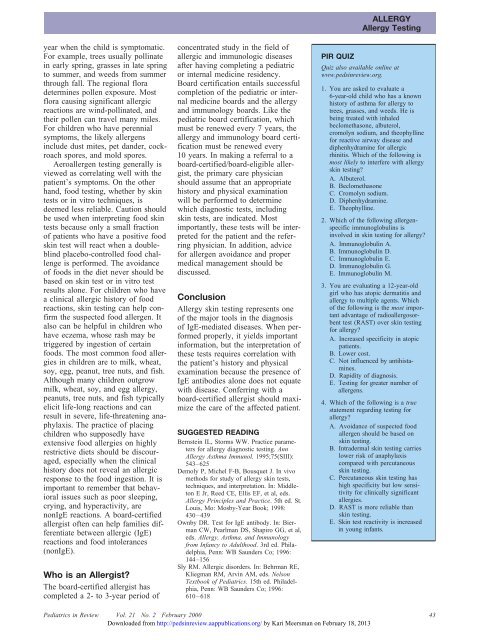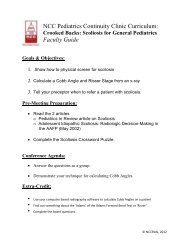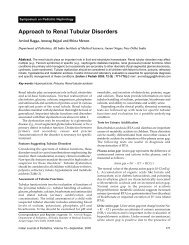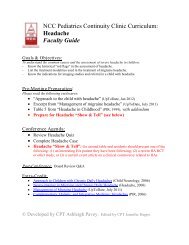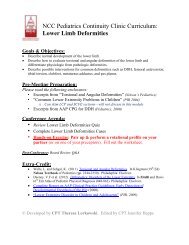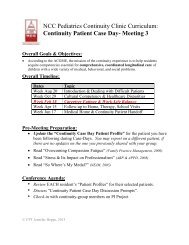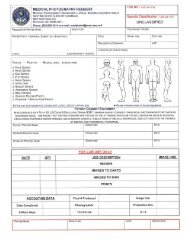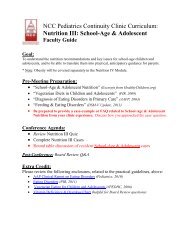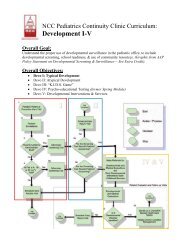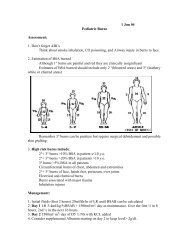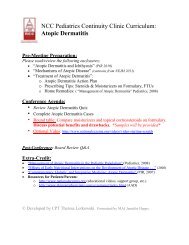Testing for Allergy - NCC Pediatrics Residency at Walter Reed
Testing for Allergy - NCC Pediatrics Residency at Walter Reed
Testing for Allergy - NCC Pediatrics Residency at Walter Reed
You also want an ePaper? Increase the reach of your titles
YUMPU automatically turns print PDFs into web optimized ePapers that Google loves.
year when the child is symptom<strong>at</strong>ic.<br />
For example, trees usually pollin<strong>at</strong>e<br />
in early spring, grasses in l<strong>at</strong>e spring<br />
to summer, and weeds from summer<br />
through fall. The regional flora<br />
determines pollen exposure. Most<br />
flora causing significant allergic<br />
reactions are wind-pollin<strong>at</strong>ed, and<br />
their pollen can travel many miles.<br />
For children who have perennial<br />
symptoms, the likely allergens<br />
include dust mites, pet dander, cockroach<br />
spores, and mold spores.<br />
Aeroallergen testing generally is<br />
viewed as correl<strong>at</strong>ing well with the<br />
p<strong>at</strong>ient’s symptoms. On the other<br />
hand, food testing, whether by skin<br />
tests or in vitro techniques, is<br />
deemed less reliable. Caution should<br />
be used when interpreting food skin<br />
tests because only a small fraction<br />
of p<strong>at</strong>ients who have a positive food<br />
skin test will react when a doubleblind<br />
placebo-controlled food challenge<br />
is per<strong>for</strong>med. The avoidance<br />
of foods in the diet never should be<br />
based on skin test or in vitro test<br />
results alone. For children who have<br />
a clinical allergic history of food<br />
reactions, skin testing can help confirm<br />
the suspected food allergen. It<br />
also can be helpful in children who<br />
have eczema, whose rash may be<br />
triggered by ingestion of certain<br />
foods. The most common food allergies<br />
in children are to milk, whe<strong>at</strong>,<br />
soy, egg, peanut, tree nuts, and fish.<br />
Although many children outgrow<br />
milk, whe<strong>at</strong>, soy, and egg allergy,<br />
peanuts, tree nuts, and fish typically<br />
elicit life-long reactions and can<br />
result in severe, life-thre<strong>at</strong>ening anaphylaxis.<br />
The practice of placing<br />
children who supposedly have<br />
extensive food allergies on highly<br />
restrictive diets should be discouraged,<br />
especially when the clinical<br />
history does not reveal an allergic<br />
response to the food ingestion. It is<br />
important to remember th<strong>at</strong> behavioral<br />
issues such as poor sleeping,<br />
crying, and hyperactivity, are<br />
nonIgE reactions. A board-certified<br />
allergist often can help families differenti<strong>at</strong>e<br />
between allergic (IgE)<br />
reactions and food intolerances<br />
(nonIgE).<br />
Who is an Allergist?<br />
The board-certified allergist has<br />
completed a 2- to 3-year period of<br />
concentr<strong>at</strong>ed study in the field of<br />
allergic and immunologic diseases<br />
after having completing a pedi<strong>at</strong>ric<br />
or internal medicine residency.<br />
Board certific<strong>at</strong>ion entails successful<br />
completion of the pedi<strong>at</strong>ric or internal<br />
medicine boards and the allergy<br />
and immunology boards. Like the<br />
pedi<strong>at</strong>ric board certific<strong>at</strong>ion, which<br />
must be renewed every 7 years, the<br />
allergy and immunology board certific<strong>at</strong>ion<br />
must be renewed every<br />
10 years. In making a referral to a<br />
board-certified/board-eligible allergist,<br />
the primary care physician<br />
should assume th<strong>at</strong> an appropri<strong>at</strong>e<br />
history and physical examin<strong>at</strong>ion<br />
will be per<strong>for</strong>med to determine<br />
which diagnostic tests, including<br />
skin tests, are indic<strong>at</strong>ed. Most<br />
importantly, these tests will be interpreted<br />
<strong>for</strong> the p<strong>at</strong>ient and the referring<br />
physician. In addition, advice<br />
<strong>for</strong> allergen avoidance and proper<br />
medical management should be<br />
discussed.<br />
Conclusion<br />
<strong>Allergy</strong> skin testing represents one<br />
of the major tools in the diagnosis<br />
of IgE-medi<strong>at</strong>ed diseases. When per<strong>for</strong>med<br />
properly, it yields important<br />
in<strong>for</strong>m<strong>at</strong>ion, but the interpret<strong>at</strong>ion of<br />
these tests requires correl<strong>at</strong>ion with<br />
the p<strong>at</strong>ient’s history and physical<br />
examin<strong>at</strong>ion because the presence of<br />
IgE antibodies alone does not equ<strong>at</strong>e<br />
with disease. Conferring with a<br />
board-certified allergist should maximize<br />
the care of the affected p<strong>at</strong>ient.<br />
SUGGESTED READING<br />
Bernstein IL, Storms WW. Practice parameters<br />
<strong>for</strong> allergy diagnostic testing. Ann<br />
<strong>Allergy</strong> Asthma Immunol. 1995;75(SIII):<br />
543–625<br />
Demoly P, Michel F-B, Bousquet J. In vivo<br />
methods <strong>for</strong> study of allergy skin tests,<br />
techniques, and interpret<strong>at</strong>ion. In: Middleton<br />
E Jr, <strong>Reed</strong> CE, Ellis EF, et al, eds.<br />
<strong>Allergy</strong> Principles and Practice. 5th ed. St.<br />
Louis, Mo: Mosby-Year Book; 1998:<br />
430–439<br />
Ownby DR. Test <strong>for</strong> IgE antibody. In: Bierman<br />
CW, Pearlman DS, Shapiro GG, et al,<br />
eds. <strong>Allergy</strong>, Asthma, and Immunology<br />
from Infancy to Adulthood. 3rd ed. Philadelphia,<br />
Penn: WB Saunders Co; 1996:<br />
144–156<br />
Sly RM. Allergic disorders. In: Behrman RE,<br />
Kliegman RM, Arvin AM, eds. Nelson<br />
Textbook of <strong>Pedi<strong>at</strong>rics</strong>. 15th ed. Philadelphia,<br />
Penn: WB Saunders Co; 1996:<br />
610–618<br />
ALLERGY<br />
<strong>Allergy</strong> <strong>Testing</strong><br />
PIR QUIZ<br />
Quiz also available online <strong>at</strong><br />
www.pedsinreview.org.<br />
1. You are asked to evalu<strong>at</strong>e a<br />
6-year-old child who has a known<br />
history of asthma <strong>for</strong> allergy to<br />
trees, grasses, and weeds. He is<br />
being tre<strong>at</strong>ed with inhaled<br />
beclomethasone, albuterol,<br />
cromolyn sodium, and theophylline<br />
<strong>for</strong> reactive airway disease and<br />
diphenhydramine <strong>for</strong> allergic<br />
rhinitis. Which of the following is<br />
most likely to interfere with allergy<br />
skin testing?<br />
A. Albuterol.<br />
B. Beclomethasone<br />
C. Cromolyn sodium.<br />
D. Diphenhydramine.<br />
E. Theophylline.<br />
2. Which of the following allergenspecific<br />
immunoglobulins is<br />
involved in skin testing <strong>for</strong> allergy?<br />
A. Immunoglobulin A.<br />
B. Immunoglobulin D.<br />
C. Immunoglobulin E.<br />
D. Immunoglobulin G.<br />
E. Immunoglobulin M.<br />
3. You are evalu<strong>at</strong>ing a 12-year-old<br />
girl who has <strong>at</strong>opic derm<strong>at</strong>itis and<br />
allergy to multiple agents. Which<br />
of the following is the most important<br />
advantage of radioallergosorbent<br />
test (RAST) over skin testing<br />
<strong>for</strong> allergy?<br />
A. Increased specificity in <strong>at</strong>opic<br />
p<strong>at</strong>ients.<br />
B. Lower cost.<br />
C. Not influenced by antihistamines.<br />
D. Rapidity of diagnosis.<br />
E. <strong>Testing</strong> <strong>for</strong> gre<strong>at</strong>er number of<br />
allergens.<br />
4. Which of the following is a true<br />
st<strong>at</strong>ement regarding testing <strong>for</strong><br />
allergy?<br />
A. Avoidance of suspected food<br />
allergen should be based on<br />
skin testing.<br />
B. Intradermal skin testing carries<br />
lower risk of anaphylaxis<br />
compared with percutaneous<br />
skin testing.<br />
C. Percutaneous skin testing has<br />
high specificity but low sensitivity<br />
<strong>for</strong> clinically significant<br />
allergies.<br />
D. RAST is more reliable than<br />
skin testing.<br />
E. Skin test reactivity is increased<br />
in young infants.<br />
<strong>Pedi<strong>at</strong>rics</strong> in Review Vol. 21 No. 2 February 2000 43<br />
Downloaded from http://pedsinreview.aappublic<strong>at</strong>ions.org/ by Kari Meersman on February 18, 2013


